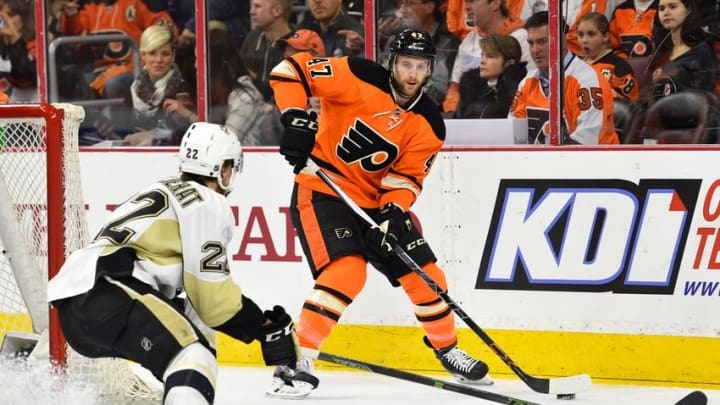Philadelphia Flyers Season Reviews: D Andrew MacDonald
By Marc Naples

Philadelphia Flyers defenseman Andrew MacDonald will try again to play up to his big salary and be a pillar of the Flyers’ defense.
No one on the Philadelphia Flyers roster gets less respect than defenseman Andrew MacDonald. Much maligned by fans, RJ Umberger is the only guy that even comes close, but Umberger never had many expectations and his contract expires soon. There is also a good chance he will be bought out soon.
Related Story: RJ Umberger Season Review
MacDonald, on the other hand, is only through 2 years of a huge 6 year contract. This contract carries a cap hit of $5 million per season. Up to this season, let’s just say MacDonald’s performance has not been worthy of that cap hit.
In reviewing MacDonald’s season, he only had a short season in the NHL. He spent most of the season in the AHL, playing 43 games there, and only 28 regular season games in the NHL. I will not go into detail on his AHL performance other than to note he put his AHL teammates to shame in production. In the AHL, he scored 36 points in those 43 games.
More from Editorials
- 5 Philadelphia Flyers training camp battles to watch
- 5 Philadelphia Flyers cheat codes for popular ‘Puckdoku’ game
- Twenty (Not So) Bold Predictions For 2023-2024 Flyers: Part 3
- Twenty (Not so) Bold Predictions for 2023-2024 Flyers: Part Two
- Philadelphia Flyers 2023-24 Player Preview: Nick Seeler
All that really matters is the NHL. On that count, MacDonald was judged to be lacking for the first half of the season. Of the Philadelphia Flyers 9-man scrum on defense, MacDonald was the one sent to the AHL. Given that you can only save ~$950,000 by sending a playing to the AHL, the Flyers were expending $4 million of cap space for MacDonald not to play.
MacDonald only got his chance with the big team when Michael Del Zotto was lost for the season to injury. Curiously, once actually added to the roster, MacDonald played quite a bit.
As the chart above shows, MacDonald played more average 5v5 minutes than every Flyers defenseman other than Del Zotto. He additionally played some penalty kill minutes.
Putting aside the paradox of the “9th defenseman” being entrusted with so many minutes, how did MacDonald perform in those minutes? Most of the evidence works against MacDonald.
Starting with the positive, MacDonald’s performance by old metrics was pretty good. MacDonald scored a respectable 8 points in 28 games, and his +10 rating was the best on the team. Compared with other defenseman, the Philadelphia Flyers were more likely to score when MacDonald was on the ice, as shown below.
There are two big factors that speak against these goal results, however. First, is that MacDonald was a beneficiary of the best possible circumstances. He joined the team during their playoff push. They really found another level to their game during this period, and MacDonald was likely more of a beneficiary of this situation than a driver of that improved play. He also mostly played with the offensively dynamic Shayne Gostisbehere.
Second, his possession statistics remain very poor. At -2.3, MacDonald’s relative Corsi percentage to his teammates was second to last among all Flyers defensemen (Schultz is by far the worst at -5.3). Poor possession statistics are nothing new for MacDonald, and much of the reason he gets a hard time from so many hockey people. While this is nothing new, it is important to note that his +10 performance in a quarter of a season is not being caused by a tangible improvement in his possession.
Furthermore, MacDonald ended up being a significant anchor on Ghost. As mentioned above, MacDonald’s most common defense partner was Shayne Gostisbehere, and that proved to drag down Ghost’s 5v5 performance. Ghost’s Corsi percentage dips to 49.0% when playing with MacDonald, while he was 50.9% in all other situations.
Overall, the advanced stats imply that MacDonald’s quality bottom-line performance is not likely a sign of things to come from the player. He dragged down possession but then benefited from an unusually high PDO of 102.91.
All of this puts MacDonald in a strange position. If I had to guess, I would expect to see MacDonald return to being an NHL regular next season. His contract is completely un-moveable, and coach Dave Hakstol seemed to like him enough down the stretch. Presuming MacDonald’s NHL performance holds to long-standing patterns of possession, hopefully Hakstol doesn’t place TOO much trust in him though.
The Philadelphia Flyers are probably looking at 8 players to take defensive spots next year; MacDonald, Ghost, Mark Streit, Nick Schultz, Michael Del Zotto, Radko Gudas, Brandon Manning, and Ivan Provorov. They may try to move Streit this offseason, in which case MacDonald almost certainly will have a spot on the team. Assuming all 8 of those players stick around, however, it may remain unclear where MacDonald ultimately fits on this team in for some time.